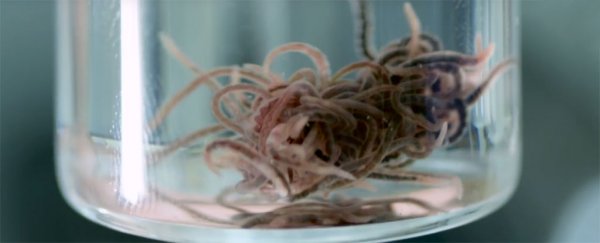Deep underground inside a toxic cave filled with poisonous sulphur gas in Colorado, scientists have identified a new species of cave worm. This new worm, blood-red in colour, never sees the light of day – but it thrives in a dank, hostile atmosphere that would kill humans.
These worms are bonafide extremophiles, meaning a species that exists in physically or geochemically extreme conditions, and have been named Limnodrilus sulphurensis, in honour of their hellish, gaseous environment. Biologist David Steinmann first came across the worms while exploring Sulphur Cave in Colorado's Steamboat Springs back in 2007, but it took more than 1,000 hours of lab work before they were officially recognised as a new species.
The worms are extremely small, measuring just an inch in length (2.5 centimetres), and are as thin as a pencil lead. They cling together in clumps dotted around the cave walls, and are partially transparent, with their red colouring coming from their blood.
"It's sort of foreboding," Steinmann, a cave biologist at the Denver Museum of Nature and Science, told Erika Engelhaupt at National Geographic, describing the dangerous conditions the worms thrive in. "You have to climb and crawl down a wet muddy slop that's stinky and smells like rotten eggs."
Once inside, it's not just the poisonous sulphur atmosphere you need to worry about – meaning you'd better be wearing a gas mask if you decide to visit (don't). Sulphuric acid strong enough to burn holes in your clothes also drips from the slimy cave ceiling. Basically, this is pretty much Indiana Jones territory.
"It's belching toxic gases," Steinmann told National Geographic, "and in the winter you can see steam coming out. You have to stoop down and squeeze through to get into the first room. Once you're in there, it's totally dark."
Not that the cave is without its charms. When lit up with artificial lights, the team found gypsum crystals glittering – perhaps for the very first time – along the cave walls. But the biggest surprise is that this threatening place turns out to make a rather cosy home for Limnodrilus sulphurensis.
"One of the exciting factors about these [cave worms] is that they show life can survive in toxic environments," Steinmann told John Wenzel at The Denver Post. "They prove that life can survive by metabolising hydrogen sulphide, which is toxic to us, and then those things can be eaten by things like worms or other creatures to create a food chain."
In the case of Sulphur Cave, the worms survive by eating sulphur-oxidising bacteria. Along with these microbes and the worms, the environment also contains spiders, flies, beetles, and other insects, forming a chemotrophic ecosystem that exists independently of the Sun's energy topside.
According to one of the team, biologist Olav Giere from the University of Hamburg in Germany, the hydrogen sulphide levels in the cave's stream are 10 times higher than those found in deep-sea volcanic vent ecosystems. It's thought that the sulphur comes from organic matter trapped in sedimentary rock deposits inside the cave.
And at those extreme levels, sulphur's rotten egg smell sticks around for a lot longer than those fleeting chemistry experiments you did in high school. "It took over a year for the sulphur smell to gradually air out from my cave coveralls," photographer Norman R. Thompson, who shot Sulphur Cave for National Geographic, told the magazine.
You can find out more about Sulphur Cave and the discovery of the worms inside it in the video below:
The findings are reported in Zootaxa.
